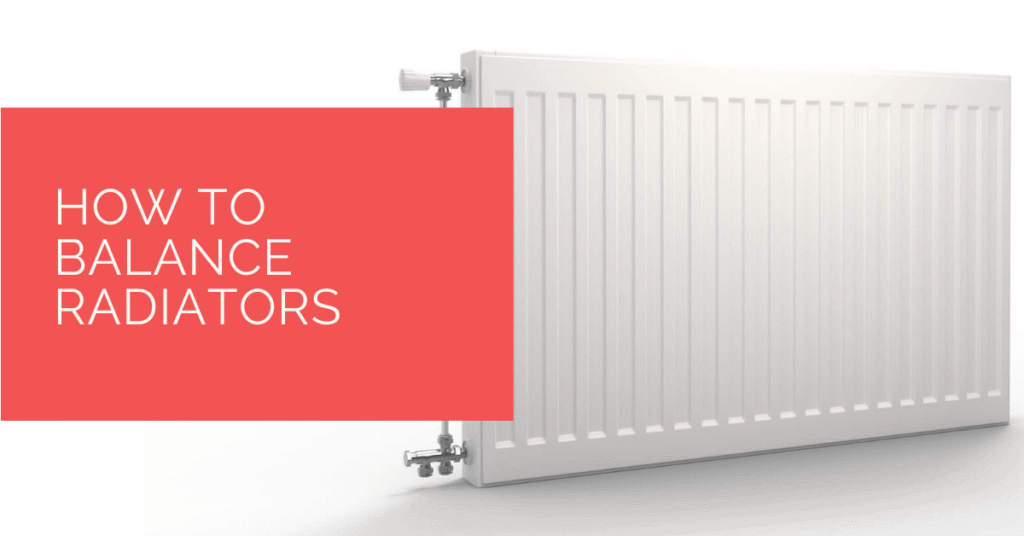When your central heating isn’t working as it should—some rooms feel too hot while others stay cold—it’s often because your radiators are out of balance. Balancing radiators ensures that hot water flows evenly through the whole heating system, giving every room consistent warmth.
- Even heating across rooms – No more hot living room and freezing bedroom.
- Lower heating costs – Balanced radiators mean your boiler works less.
- Longer system lifespan – Reduces strain on pumps and pipes.
- Supports ECO4 heating upgrades – Essential if you install A-rated boilers or heat pumps through government grants.
Whether you’ve installed a new boiler under the ECO4 scheme, are dealing with uneven heating, or simply want to reduce your energy bills, learning how to balance radiators is an essential step.
What Does Balancing Radiators Mean?
Balancing radiators means adjusting the water flow through each radiator so that all heat up evenly. Unlike bleeding radiators, which removes trapped air, balancing is about controlling how much hot water passes through.
Signs you need radiator balancing include:
- Some radiators heat up much faster than others.
- Cold spots in certain rooms.
- Higher heating bills despite a warm boiler.
Related keywords: radiator balancing guide, uneven heating radiators, central heating efficiency.
Why Balancing Radiators Matters
Balancing radiators is more than just comfort—it helps improve overall heating efficiency.
Related keywords: ECO4 heating efficiency, heating system performance, save money on heating.
Tools You’ll Need
Before you start balancing radiators, make sure you have the right tools:
- Radiator key (for bleeding first)
- Thermometer or digital probe (to measure flow/return temperatures)
- Lockshield valve adjuster or spanner
- Screwdriver (if required for valve caps)
Related keywords: radiator key, lockshield valve, radiator balancing tools.
Step-by-Step Guide: How Do You Balance Radiators?
Follow these simple steps for a balanced central heating system:
- Switch off heating – Let radiators cool completely.
- Bleed radiators – Use a radiator key to remove trapped air.
- Turn heating back on – Note which radiators heat first (they usually need restricting).
- Adjust lockshield valves – Slightly close valves on radiators that get hot quickly.
- Apply the 12-Degree Rule – The difference between the flow pipe and return pipe temperature should be around 12°C.
- Fine-tune each radiator – Keep adjusting until all radiators heat evenly.
Related keywords: balancing radiators step by step, 12-degree rule radiator balancing, DIY radiator balancing tips.
Common Mistakes to Avoid
- Confusing bleeding with balancing.
- Closing lockshield valves too much, restricting flow.
- Ignoring sludge buildup that requires a system flush.
- Forgetting to check after a boiler upgrade or heating system change.
Radiator Balancing and ECO4 Scheme
If you qualify for the ECO4 grant, balancing radiators becomes even more important. ECO4-funded upgrades such as new boilers, air source heat pumps, and insulation work best when radiators are properly balanced.
By following the 12-degree radiator rule, you can ensure your ECO4 heating upgrade delivers maximum energy efficiency and lower bills.
Related keywords: ECO4 scheme, ECO4 heating upgrades, energy-saving grants UK.
DIY vs Professional Radiator Balancing
- DIY balancing – Ideal if you’re confident with tools and patient with adjustments.
- Professional balancing – Recommended if you have a complex heating system, sludge issues, or recently installed a new ECO4 boiler or heat pump.
Blog Summary Table
| Step | Action | Why It’s Important |
|---|---|---|
| 1 | Bleed radiators | Removes trapped air for smooth flow |
| 2 | Identify hot/cold radiators | Highlights imbalance in system |
| 3 | Adjust lockshield valves | Controls water flow to each radiator |
| 4 | Apply 12-degree rule | Ensures consistent heating efficiency |
| 5 | Re-check system | Confirms all radiators heat evenly |
Conclusion
Balancing radiators might sound technical, but with the right approach it’s straightforward and rewarding. A properly balanced heating system means warmer homes, lower bills, and better performance of ECO4-funded upgrades.
If you’re unsure, a heating engineer can carry out professional radiator balancing and ensure your system runs at peak efficiency.
Frequently Asked Questions
How often should I balance my radiators?
Balance your radiators every 1–2 years, or after installing a new boiler or radiator.
What’s the difference between bleeding and balancing?
Bleeding removes trapped air; balancing adjusts water flow so all radiators heat evenly.
Can I balance radiators without a thermometer?
Yes, but a thermometer or digital probe makes the process more accurate and quicker.
Do I need to balance radiators after ECO4 upgrades?
Yes. After a new boiler or heat pump under ECO4, balancing ensures maximum efficiency.
Does radiator balancing lower energy bills?
It helps reduce wasted energy and can lower heating bills by improving heat distribution.
